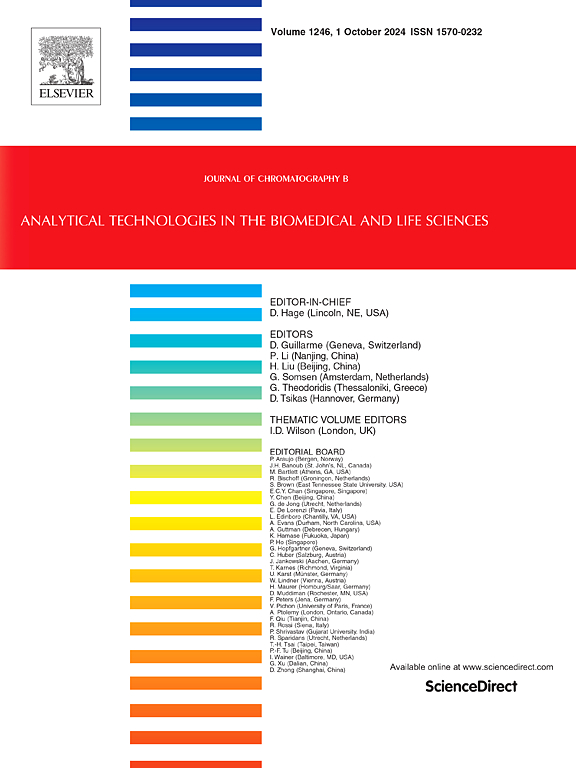Evaluation of the effect of Ela tablets in the treatment of diabetic nephropathy based on rat experiments and screening strategy for quality markers of Ela tablets targeting aldose reductase
IF 2.8
3区 医学
Q2 BIOCHEMICAL RESEARCH METHODS
引用次数: 0
Abstract
Ela tablets (ALP) is a traditional Uyghur medicinal formulation comprising 9 herbs. Clinical applications have demonstrated its potential in treating diabetic nephropathy (DN). However, its specific medicinal effects and pharmacodynamic components have not been elucidated. This research aims to investigate the efficacy of ALP in treating DN and to explore the quality markers (Q-markers) for its exertion of efficacy. Using the UHPLC-Q-Orbitrap HRMS technique, a total of 60 compounds were identified within ALP. Animal experiments were conducted to investigate the effect of ALP intervention at doses of 80, 160, and 320 mg/kg in Sprague-Dawley rats. Then, fingerprints of ten batches of ALP extracts were established using UPLC-DAD. Spectrum-effect relationship analysis of these fingerprints and aldose reductase (AR) activity was conducted by chemometric analysis methods. The results were further validated by molecular docking and cellular experiments. The animal experiments indicated that ALP had a therapeutic effect on DN. Specifically, ALP reduced biochemical indexes such as serum creatinine (SCr), 24-hour urinary total protein (24 h UTP), uric acid (UA), blood urea nitrogen (BUN), triglycerides (TG), and total cholesterol (TC). ALP stabilized body weight and fasting blood glucose, enhanced the antioxidant capacity of kidneys, and improved renal pathology. Comprehensive analysis indicated that crocin-I and gallic acid may be used as Q-markers for ALP. In summary, ALP has been identified as a treatment for DN, and gallic acid and crocin-I can be used as its Q-markers.

基于大鼠实验的Ela片治疗糖尿病肾病的疗效评价及针对醛糖还原酶的Ela片质量标记物筛选策略
埃拉片(ALP)是维吾尔族传统药材配方,由9种草药组成。临床应用已证明其在治疗糖尿病肾病(DN)方面的潜力。然而,其具体的药理作用和药效学成分尚未阐明。本研究旨在探讨ALP治疗DN的疗效,并探讨其发挥疗效的质量标记(q -marker)。采用UHPLC-Q-Orbitrap HRMS技术,共鉴定出60个化合物。采用动物实验研究80、160、320 mg/kg ALP对Sprague-Dawley大鼠的干预效果。采用UPLC-DAD建立10批ALP提取物的指纹图谱。采用化学计量学方法对指纹图谱与醛糖还原酶(AR)活性进行了光谱效应关系分析。通过分子对接和细胞实验进一步验证了这一结果。动物实验表明ALP对DN有治疗作用。具体来说,ALP降低了血清肌酐(SCr)、24小时尿总蛋白(24 h UTP)、尿酸(UA)、血尿素氮(BUN)、甘油三酯(TG)和总胆固醇(TC)等生化指标。ALP稳定体重和空腹血糖,增强肾脏的抗氧化能力,改善肾脏病理。综合分析表明,藏红花素i和没食子酸可作为ALP的q标记物。综上所述,ALP已被确定为DN的治疗方法,没食子酸和藏红花素i可作为其q标记物。
本文章由计算机程序翻译,如有差异,请以英文原文为准。
求助全文
约1分钟内获得全文
求助全文
来源期刊

Journal of Chromatography B
医学-分析化学
CiteScore
5.60
自引率
3.30%
发文量
306
审稿时长
44 days
期刊介绍:
The Journal of Chromatography B publishes papers on developments in separation science relevant to biology and biomedical research including both fundamental advances and applications. Analytical techniques which may be considered include the various facets of chromatography, electrophoresis and related methods, affinity and immunoaffinity-based methodologies, hyphenated and other multi-dimensional techniques, and microanalytical approaches. The journal also considers articles reporting developments in sample preparation, detection techniques including mass spectrometry, and data handling and analysis.
Developments related to preparative separations for the isolation and purification of components of biological systems may be published, including chromatographic and electrophoretic methods, affinity separations, field flow fractionation and other preparative approaches.
Applications to the analysis of biological systems and samples will be considered when the analytical science contains a significant element of novelty, e.g. a new approach to the separation of a compound, novel combination of analytical techniques, or significantly improved analytical performance.
 求助内容:
求助内容: 应助结果提醒方式:
应助结果提醒方式:


